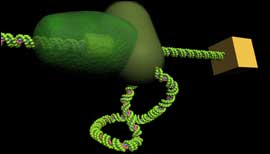| Posted: October 25, 2006 |
DNA switch developed to interface living organisms with computers |
|
(Nanowerk News) Researchers at the University of Portsmouth have developed an electronic switch based on DNA - a world-first bio-nanotechnology breakthrough that provides the foundation for the interface between living organisms and the computer world....
|
 |
|
The new technology is called a 'nanoactuator' (shown in the image above) or a molecular dynamo. The device is invisible to the naked eye - about one thousandth of a strand of human hair.
|
|
The DNA switch has been developed by British Molecular Biotechnology expert Dr Keith Firman at the University of Portsmouth working in collaboration with other European researchers.
|
|
Dr Firman and his international team have been awarded a €2 million (£1.36m) European Commission grant under its New and Emerging Science and Technology (NEST) initiative to further develop this ground-breaking new technology.
|
|
But the DNA switch has immediate practical applications in toxin detection, and could be used in a biodefence role as a biological sensor to detect airborne pathogens.
|
|
The future applications are also considerable, including molecular scale mechanical devices for interfacing to computer-controlled artificial limbs.
|
|
'The possibilities are very exciting. The nanoactuator we have developed can be used as a communicator between the biological and silicon worlds,' Dr Firman said.
|
|
'I could see it providing an interface between muscle and external devices, but it has to be pointed out that such an application is still 20 or 30 years away.'
|
|
The molecular switch comprises of a strand of DNA anchored in a miniscule channel of a microchip, a magnetic bead, and a biological motor powered by the naturally occurring energy source found in living cells, adenosine triphosphate (ATP).
|
|
These elements working together create a dynamo effect which in turn generates electricity. The result is a device that emits electrical signals - signals that can be sent to a computer. The switch, therefore, links the biological world with the silicon world of electronic signals.
|
|
The nanoactuator has been patented by the University of Portsmouth, and a patent application for the basic concepts of biosensing is pending.
|
|
The nanoactuator project is part of a multinational collaboration between the University of Portsmouth, The National Physical Laboratory (UK), TU Delft (The Netherlands), CNRS/ENS (France), INESC-Portugal, EMPA (Switzerland) and IMIC (Czech Republic).
|

